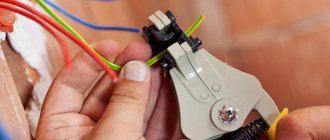Classification of premises for electrical safety (PUE clause 1.1.13)
⇐ PreviousPage 3 of 4Next ⇒
Premises without increased danger - there are no conditions of increased danger
Premises with increased danger - characterized by the presence of one of the following conditions creating an increased danger:
a) dampness (more than 75%);
b) conductive floors (metal, earthen, reinforced concrete, brick, etc.);
c) high temperature;
d) conductive dust;
e) the possibility of simultaneous human contact with metal structures of buildings connected to the ground, technological devices, mechanisms, etc., on the one hand, and with metal casings of electrical equipment (exposed conductive parts), on the other;
Particularly dangerous premises
a) special dampness;
b) chemically active or organic environment;
c) 2 or more high-risk conditions at the same time.
In terms of the danger of electric shock to people, the territory of open electrical installations is equated to especially dangerous premises.
Damp areas - relative humidity above 75%
Particularly damp rooms - relative humidity close to 100%
Hot rooms - the temperature constantly or periodically (more than a day) exceeds 35°C
Dusty premises - due to production conditions, process dust is released.
A room with a chemically active or organic environment - aggressive vapors, gases, liquids are constantly or for a long time contained, deposits and mold are formed.
Portable and mobile electrical receivers (POTEU clauses 44.1-44.10)
Portable power tool classes
0 - electrical receivers that have working insulation, do not have elements for grounding and are not classified as class II or III
I - electrical receivers that have working insulation and an element for grounding. The wire for connection to the power source must have a grounding conductor and a plug with a grounding contact. The designation of the grounding contact is PE or white-green stripes or the word “earth” in a circle
II - having double or reinforced insulation and not having elements for grounding. Designation: double square
III - electrical receivers for operation at safe extra-low voltage, having neither external nor internal electrical circuits operating at a different voltage. Designation: rhombus with III
Ultra-low (low) voltage - not exceeding 50 V AC or 120 V DC.
Workers with group II must be allowed to work with portable power tools and hand-held electrical machines of classes 0 and I in areas with increased danger.
Connecting auxiliary equipment (transformers, frequency converters, residual current devices) to the electrical network and disconnecting it from the network must be carried out by electrical personnel with group III operating this electrical network.
The class of portable power tools and hand-held electrical machines must correspond to the category of the premises and the conditions of work, using, in some cases, electrical protective equipment in accordance with the requirements.
In high-risk and especially dangerous areas, portable electric lamps must have a voltage of no higher than 50 V.
When working in particularly unfavorable conditions (switch wells, switchgear compartments, boiler drums, metal tanks), portable lamps must have a voltage of no higher than 12 V.
Before starting work with hand-held electrical machines, portable power tools and lamps, you should:
- determine the class of the machine or tool from the passport;
-check the completeness and reliability of fastening parts;
- make sure by external inspection that the cable (cord), its protective tube and plug are in good condition, the integrity of the insulating parts of the case, handle and brush holder covers, protective covers;
-check the correct operation of the switch;
-perform (if necessary) testing of the residual current device (RCD);
-check the operation of the power tool or machine at idle speed;
- check the serviceability of the grounding circuit of a class I machine (machine body - grounding contact of the plug).
It is not allowed to use hand-held electric machines, portable power tools and lamps with related auxiliary equipment that have defects and have not undergone periodic inspection (testing).
When using power tools, hand-held electrical machines, portable lamps, their wires and cables should be suspended whenever possible.
Direct contact of wires and cables with hot, wet or oily surfaces or objects is not allowed.
The power tool cable must be protected from accidental mechanical damage and contact with hot, damp and oily surfaces.
It is not allowed to pull, twist or bend the cable, place a load on it, or allow it to intersect with cables, cables, or gas welding hoses.
If any malfunctions are detected, work with hand-held electrical machines, portable power tools and lamps must be stopped immediately.
Hand-held electrical machines, portable power tools and lamps, auxiliary equipment issued and used in work must be taken into account in the organization (separate unit), be checked and tested within the time limits and volumes established by technical regulations, national and interstate standards, technical specifications for products in force volume and standards for testing electrical equipment and electrical installations.
To maintain good condition, conduct periodic tests and inspections of hand-held electrical machines, portable power tools and lamps, auxiliary equipment, a responsible employee with group III must be appointed by order of the head of the organization.
In the event of a power failure or interruption in operation, power tools and hand-held electrical machines must be disconnected from the electrical network.
Workers using power tools and hand-held electrical machines are prohibited from:
- transfer manual electric machines and power tools, at least for a short time, to other employees;
- disassemble hand-held electrical machines and power tools, make any repairs;
- hold onto the wire of an electric machine, power tool, touch rotating parts or remove shavings and sawdust until the tool or machine comes to a complete stop;
- install the working part into the chuck of a tool, machine and remove it from the chuck, as well as adjust the tool without disconnecting it from the network;
work from ladders;
- bring portable transformers and frequency converters inside boiler drums and metal tanks.
When using an isolation transformer, the following requirements must be followed:
- only one power receiver is allowed to be powered from the isolation transformer;
- grounding of the secondary winding of the isolation transformer is not allowed;
- the transformer housing, depending on the neutral mode of the supply electrical network, must be grounded or neutralized. In this case, grounding the housing of the electrical receiver connected to the isolation transformer is not required.
The frequency of checking portable and mobile electrical receivers and auxiliary equipment for them is at least once every 6 months. The results of the inspection are reflected in the logbook, inventory control, periodic inspection and repair of portable mobile electrical receivers.
Periodic inspection includes:
1. external inspection
2. Check idling for at least 5 minutes
3. Insulation resistance measurement
4. checking the serviceability of the grounding circuit
⇐ Previous3Next ⇒
Recommended pages:
Classification of premises according to electrical safety
Measures to ensure electrical safety depend on the purpose of the room in which the electrical installation is located and on the nature of the room. In this article we will look at ways to classify premises according to electrical safety.
According to their purpose, premises are distinguished into: specialized premises with electrical installations and premises for other purposes (industrial, household, service, retail, etc.).
Premises with electrical installations are those rooms or fenced-off parts of the premises in which operating electrical equipment is installed and which are accessible only to personnel who have the necessary qualifications and approval to service electrical installations. Premises with electrical installations are usually characterized by conditions that differ from normal conditions, increased temperature, humidity and a large number of metal equipment connected to the ground. All this creates an increased risk of electric shock.
The Rules for the Construction of Electrical Installations (PUE) provide the following classification of premises: dry, damp, damp, especially damp, hot and dusty.
Dry rooms are rooms in which the relative air humidity does not exceed 60%.
Wet rooms are rooms in which steam and condensing moisture are released only briefly in small quantities, and the relative air humidity is more than 60%, but does not exceed 75%.
Damp rooms are rooms in which the relative air humidity exceeds 75% for a long time.
Particularly damp rooms are those in which the relative air humidity is close to 100% (ceilings, walls, floors and objects in the room are covered with moisture).
Hot rooms are rooms in which, under the influence of various thermal radiation, the temperature constantly or periodically (more than a day) exceeds 35 ° C.
Dusty rooms are rooms in which, due to production conditions, process dust is released in such quantities that it can settle on wires, penetrate into machines, devices, etc. Dusty rooms are divided into rooms with conductive dust and rooms with non-conductive dust. In addition, there are rooms with a chemically active or organic environment, where aggressive vapors, gases, liquids are constantly or for a long time contained, deposits or mold are formed that destroy the insulation and live parts of electrical equipment.
Taking into account these signs, all premises are divided into three classes according to the degree of danger of electric shock.
1st class premises. Particularly hazardous premises, which are characterized by the presence of one of the following conditions that create a particular danger: special dampness (100% humidity), a chemically active or organic environment, or two or more conditions of increased danger at the same time. With regard to the danger of electric shock to personnel, the areas where outdoor electrical installations are located are equated to particularly dangerous premises.
2nd class premises. Premises with increased danger, which are characterized by the presence of one of the following conditions that create increased danger: dampness (more than 75% humidity) or conductive dust, conductive floors (metal, earthen, reinforced concrete, brick, etc.), high temperature ( more than +35°C), the possibility of simultaneous human touch to metal structures of buildings connected to the ground, technological devices, mechanisms, on the one hand, and to metal housings of electrical equipment, on the other hand.
Class 3 premises. Premises without increased danger, in which there are no conditions that create increased or special danger.









